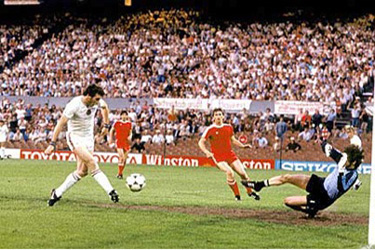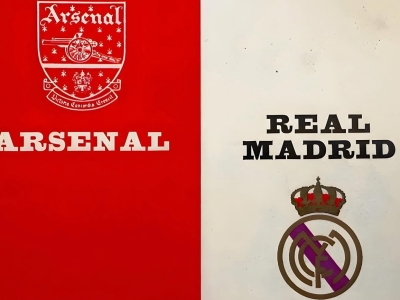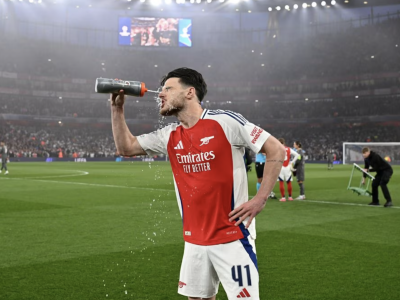Aston Villa were founded in 1874 by members of the Villa Wesleyan Cross Chapel, a church which stood at Villa Cross – a junction in Handsworth between Heathfield Road, Villa Road and Lozells Road, named after the Villa Cross Tavern, a pub which stood until 1985 when it was destroyed in the Handsworth riots. The 1st Series Ordnance Survey map of 1834 actually refers to this area as ‘Aston Villa’. Like many other major English Football clubs, Aston Villa were formed by four players from the Villa Cross Wesleyan Chapel cricket team, who were looking for a pastime to pursue during the winter months and chose Football after witnessing an impromptu game on a meadow off Heathfield Road.
Villa played their first match in March 1875, as they were unable to find a suitable opponent – many existing association football sides in the area were considered too strong. Their first match was played against Aston Brook St Mary's Rugby team, with one half of the match to be played under Rugby rules and one half under the 'Sheffield Rules' laws of association football. The first half was a ‘try-less’ draw, with Villa winning in the second half 1-0. Like Arsenal, Villa are another club whose founding fathers contained several influential members of Scots origin – such as their Captain, George Ramsey - hence the reason why the Villa crest has the rampant lion akin to that of the Royal Standard of Scotland.
A turning point in the history of Aston Villa however came with the introduction of another Scotsman, William McGregor, who first became associated with Villa as a committee member in 1877. McGregor had moved from Perthshire to Birmingham to run a drapery business close to Aston Park, where at the time Villa played their home fixtures. The Villa acquired their first piece of silverware in 1880, winning the Birmingham Senior Cup. That year they also entered the FA Cup for the first time, though drew the then successful Oxford University. Villa though withdrew from the match feeling that they couldn’t afford the travel expenses for the tie. Aston Villa however won their first FA Cup in 1887, beating local rivals West Brom 2-0 in the Final at the Kennington Oval.
Aston Villa turned professional in 1885 when professionalism was legalised by the FA. McGregor noted that once Villa became a professional side they required a regular set of matches in order to sustain themselves financially, however many of the friendlies which the club previously arranged were cancelled due to opponents' being involved in cup matches or failing to honour a fixture choosing instead a more lucrative match elsewhere. In 1888, Villa experienced this on five consecutive Saturdays, which led William McGregor to take action to rectify. On the eve of the 1888 FA Cup Final McGregor arranged a meeting of several committee members of other clubs. McGregor had been inspired by the American Association Baseball League in the USA and decided in turn to create a similar league structure between professional football sides in England, which led to the foundation of the Football League later that same year and McGregor serving as the first chairman of the League's Management Committee.
Villa finished the first League season second in the table, albeit eleven points behind Preston’s ‘invincibles’ under a two points for a win system. Sadly, the following year Villa’s captain George Ramsey suffered a heart attack during a game against Everton and retired on medical advice, though died four years later at the age of just thirty five. Aston Villa reached the FA Cup Final again in 1892, though this time lost 0-3 to West Brom at Kennington Oval. Two seasons on the Villa won their first league title, finishing six points clear of runners up Sunderland. Aston Villa would also win the FA Cup again in 1895, beating West Brom 1-0 in the first final to be played at Crystal Palace, with a goal from Bob Chatt scored around thirty seconds after the kick off.
Villa would be the last winners of the original FA Cup trophy. After their 1895 victory however, the trophy was stolen from a Birmingham shoe shop window belonging to William Shillcock on the now infamous date of 11th September (which other than the notorious terrorist attack in New York in 2001 was also the day in which Fletch from Porridge was sentenced to imprisonment) in 1895 and was never to be seen again. Villa were fined £25 by the FA to pay for a replacement trophy – the large handled one which is now recognised the world over. Villa would also win their second league championship in 1895/96, beating second place Derby County to the title by four points.
Not only would Villa retain their title the following season (this time by an even bigger margin of nine points), they would become the second club to complete the League and FA Cup double and would be the last club to achieve this feat for the next sixty four years. One week after completing the double, Villa would move to their new ground, then known as Aston Lower Grounds but since the turn of the century became known as Villa Park. Back to back titles would also follow again in 1898/99 and 1899/1900, however in 1900/01 sunk to just two places above the relegation zone. Woolwich Arsenal’s first visit to Villa Park took place on Boxing Day 1904, with Villa inflicting a 1-3 defeat on Arsenal with goals from Joe Bache, Alec Leake and Harry Hampton, with Charlie Satterthwaite scoring for the Arsenal.
Four months later came the earliest available footage of an Aston Villa game captured on film by early film makers Mitchell and Kenyon, playing away at Blackburn in April 1904. The following year Aston Villa won their fourth FA Cup, beating Newcastle United 1-0 at Crystal Palace. Woolwich Arsenal’s first win at Villa Park came in October 1907 with a goal from David Neave. Villa’s last league championship for the next seven decades came in 1909/10, finishing five points clear of Liverpool in second place. William McGregor, a major force during Villa’s golden era, however would pass away in December 1911 at the age of sixty five.
Villa would go on to win the penultimate FA Cup Final to be held at Crystal Palace, beating Sunderland 1-0 in 1913, as well as the first FA Cup Final to be played after the First World War in 1920, beating Huddersfield Town 1-0 at Stamford Bridge, with a goal from Billy Kirton ten minutes into extra time. The inter-war period however was one of relative decline for Aston Villa. The Villa would reach the second ever final to be played at Wembley in 1924, the Cup run started away at non-league Ashington with a 5-1 win over the side from the Northumberland mining town which produced the Charlton Brothers and their cousin ‘Wor Jackie’ Milburn. Villa would beat Burnley 3-0 in the Semi Final at Hillsborough, however would lose the final against Newcastle 0-2.
Aston Villa’s best FA Cup run for the remainder of that decade came in 1928/29, were they met Arsenal in the Quarter Final at Villa Park inflicting a 0-1 defeat on the Gunners with a goal from Thomas ‘Pongo’ Waring – a nickname not given as a result of his poor personal hygiene but after a famous cartoon character of the time. During the late twenties and early to mid-thirties, Pongo went on to score an incredible 159 goals in 216 appearances for Villa. On his death in 1980 his ashes were scattered in the goal mouth at the Holte End before a game against Stoke City. Villa however were to lose the FA Cup Semi Final 0-1 to Portsmouth at Highbury that season.
After that Quarter Final in 1929 however the balance of power would swing in favour of Arsenal, who won four titles in five years in the early thirties. On two of those occasions the runners up were Aston Villa. During the period there were many high scoring fixtures between the two sides, with Arsenal knocking Villa out of the FA Cup in a third round replay in 1931 with a 3-1 win achieved with goals from David Jack and two for Joe Hulme for the Gunners with Pongo Waring on target for Villa. Two months later however Villa would inflict a 1-5 defeat on Arsenal at Villa Park in the League, though Arsenal would take the title beating Villa in second place by four points. In November 1932, Aston Villa inflicted a 3-5 defeat on Arsenal with Jack Lambert, David Jack and Cliff Bastin on the scoresheet for the Arsenal. At the end of that season however Arsenal regained their title, finishing four points ahead of Villa. Over the next three years however, Villa would suffer a sharp decline and by 1935/36 were languishing in the relegation zone. In December 1935 would come Arsenal’s famed visit to Villa Park in which the Gunners would walk away with the points courtesy of a 7-1 victory in which Ted Drake would score all seven – a record which still stands to this day.
Aston Villa would finish the season in twenty first position and relegated from the top tier of English Football for the first time in their history. Villa would spend two seasons in the second tier, returning to the top flight as Champions of the old Second Division in 1937/38. That same year also reaching the FA Cup Semi Finals, losing to Preston North End 1-3 at Hillsborough. Villa retained their position in the top flight ahead of the outbreak of the Second World War, with Movietone News footage of Villa boss Jimmy Hogan coaching Football to the troops in 1940. For the most part of the early post war period Aston Villa slipped into mid-table mediocrity and stopped challenging for honours. Arsenal visited Aston Villa on the opening day of the 1952/53 season, captured here by Movietone News. The Villa Park crowd seemed displeased by Alex Forbes’s trickery and in the words of the narrator ,‘made a very different noise’ when Villa took the lead. The narrator also noted that ‘in the event Arsenal won (by the final result of 2-1 with goals from Doug Lishman and Don Oakes)…whatever this means that this stage of the season’ (a heck of a lot as it turned out, as Arsenal would win the title on the last day at home to Burnley on goal average).
In 1957 Villa would return to trophy winning ways in that year’s FA Cup Final, preventing the ‘Busby Babes’ of Manchester United becoming the first side since Aston Villa sixty years earlier to win the now ‘elusive’ League and FA Cup double. A controversial (but then entirely Legal) challenge by Villa forward Peter McParland on United’s goalkeeper Ray Wood, left the latter unconscious with a broken cheekbone. Jackie Blanchflower took over in goal for United for the remainder of the game, but (this being the era before substitutes were permitted) incredibly Wood actually re-joined the game in an outfield position later in the match, but barely involved in the action as a virtual passenger before returning to goal for the last seven minutes of the game. McParland would go on to be Aston Villa’s hero that day, scoring both of Villa’s goals in a 2-1 victory over Man Utd, giving them a record seventh Cup win, despite not winning a trophy for thirty seven years prior. This record would last until as late as the early 1990s, though Villa have yet to win another FA Cup since.
Aston Villa would face relegation again however just two years after their FA Cup win. Former Arsenal captain Joe Mercer was unable to stop Villa’s slide, finishing second from bottom in the table. Villa however still reached the Semi Finals of the FA Cup in 1959, though defeated by Nottingham Forest 0-1 at Hillsborough. Mercer however would return Villa to the top flight the following season as Second tier champions, as well as reaching the Semi Finals of the FA Cup again, though would lose 0-1 to Wolves at nearby West Brom. In 1960/61 a young side dubbed ‘Mercer’s Minors’ would won the inaugural League Cup final, which due to fixture congestion would actually conclude at the start of the following season.
In August 1961, Villa would lose the first leg 0-2 to second tier Rotherham United, however at the start of September at Villa Park in the second leg Villa would draw level to take the game to extra-time where Peter McParland would again score the winner. Just hours after the game however, tragedy would strike as Villa players Bobby Thomson and Derek Dougan would be involved in a road traffic accident in which their friend, twenty three year old journalist Malcolm Williams, would lose his life. Also incredibly, Villa’s defence of the trophy would commence just eight days after winning the trophy!
Villa’s star striker during this period was Gerry Hitchins who scored an impressive 78 goals in 132 appearances for Villa. After scoring for England away against Italy, Hitchins impressed Inter Milan scouts who with the ‘lure of the Lira’ signed him from Villa. He would go on to be a hit in Serie A, also turning out for Torino, Atalanta and Cagliari. Sir Alf Ramsey however preferred home based players, which meant his England career was effectively ended by his move to Italy, despite a record of five goals in seven appearances at international level. Hitchens sadly died at the age of just forty eight from a heart attack during a charity game in 1983.
Aston Villa would reach the League Cup Final again in 1963 against local rivals Birmingham City, however this time would lose the first leg of the final 1-3 at St. Andrews and could only muster a 0-0 draw at Villa Park in the second leg. Joe Mercer suffered a stroke in 1964 and, despite recovering, received the sack from Aston Villa. However the club would spend the next four season in the bottom half of the table, before finally falling out of the top tier in 1966/67 finishing second from bottom. The final meeting between Arsenal and Villa before the latter fell out of the top tier came on New Years’ Eve of 1966, with Arsenal winning 1-0 with a goal from Frank McLintock.
For Villa worse was to follow, as after two seasons spent in the bottom half of the second tier would slip to the third tier of English football for the first time in their history by finishing second from bottom in the old second division. The club’s top scorer for the 1969/70 season, future Arsenal boss Bruce Rioch, scored just six goals all season. Villa’s decline led to the resignation of the club’s board of directors and the club were bought out by a London financier called Pat Matthews, who introduced a local travel agent, former Birmingham City director and future Villa director Doug Ellis onto the board. While in the third tier in 1970/71, Villa again experienced success in the League Cup reaching the Semi Final against Manchester United.
After a 1-1 draw at Old Trafford, Villa pulled off a 2-1 win back at Villa Park a week later to secure a final date at Wembley against Tottenham. Third tier Villa held on for seventy eight minutes before Martin Chivers put Spurs ahead (commentator Brian Moore fuelling speculation that he might be an Arsenal fan by proclaiming that ‘Spurs are ahead, and they really don’t deserve to be’). A second for Chivers four minutes later meant a 0-2 defeat for Villa. Villa missed out on promotion that year, however would win the third tier championship in 1971/72, as well as marking that season with a 2-1 win over Pele’s Santos in a friendly at Villa Park.
While in the second tier Arsenal would meet Aston Villa for the first time in seven years in the fourth round of the FA Cup. After a 1-1 draw at Highbury, Arsenal headed to Villa Park four days later where Aston Villa would inflict a 0-2 defeat on the Gunners. Among the goals for Villa would be former Liverpool striker and 1971 Cup Finalist Alun Evans. Villa would appoint their most successful manager in modern times, Ron Saunders, as manager in 1974/75 and would incredibly reach the final of the League Cup for the third time with a three different clubs. That season, they would meet his former club, Norwich City. The Semi Finals of the League Cup that season would include four teams from outside the top tier – second tier Norwich and Manchester United with the former beating the latter and Villa meeting fourth tier Chester and winning 5-4 on aggregate.








